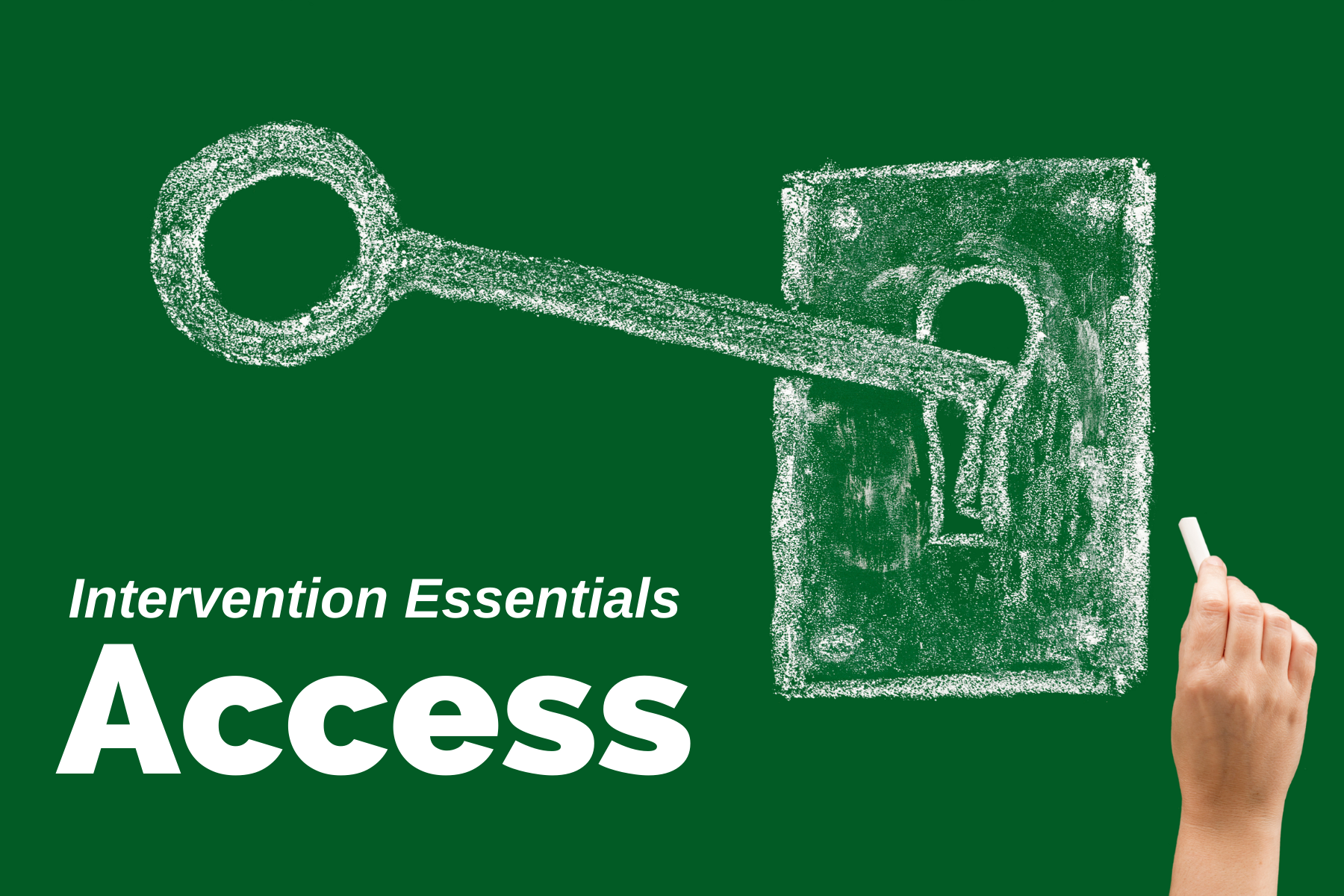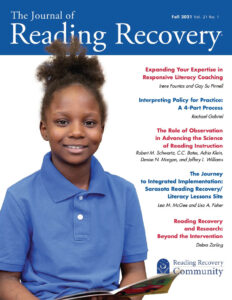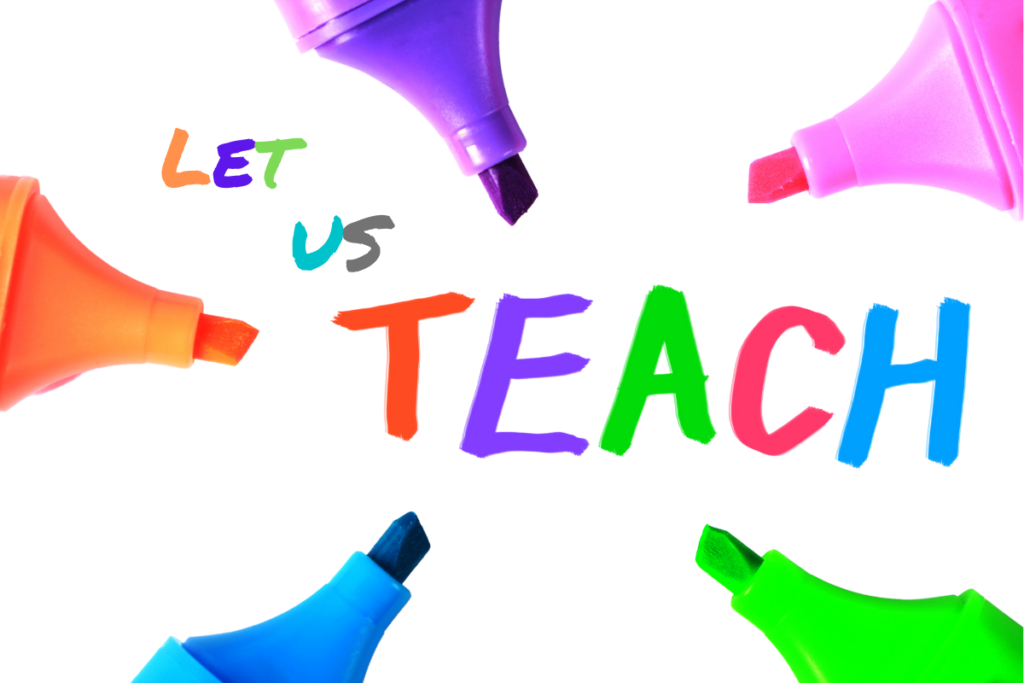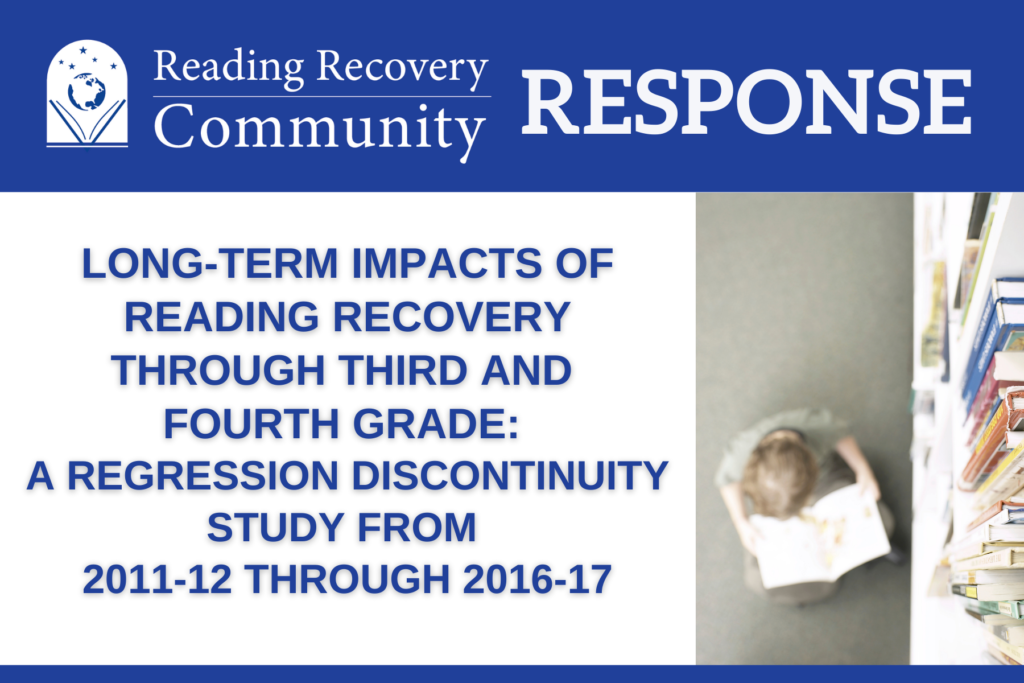BLOG
Intervention Essentials Part 1: Guaranteed Access to a Full Series of Lessons
by Connie Briggs
Why does the Reading Recovery trademark guarantee participating students a full series of lessons
that may be up to 20 weeks of instruction?
“The quality and integrity of your implementation [Reading Recovery] is protected by a trademark annually granted to sites, pending a review of adherence with the Standards and Guidelines of Reading Recovery in the United States …” (Reading Recovery Council of North America, [RRCNA], 2021, p. 33). With over 35 years of research and excellent national student outcome data, schools and districts that adhere to standards and guidelines—and employ an effective implementation plan—can be assured that investing in Reading Recovery will reduce the number of children with reading difficulties and the long-term cost to their systems for educating these children. Adherence to all aspects of the Reading Recovery standards, guidelines, and procedures is key to establishing and maintaining effective interventions.
What is a Full Series of Lessons?
Per Clay’s (2016) design for this intervention, every Reading Recovery student is entitled to a full series of Reading Recovery lessons, and that is individual lessons of 30 minutes daily for a maximum of 20 weeks. Some children will not require the maximum weeks of instruction. They will accelerate their literacy learning and demonstrate the proficiency levels, the literacy processing system, and the learner independence required to ensure their continued literacy learning with less than 20 weeks of instruction. Their series of Reading Recovery lessons then ends as they have achieved intervention goals. They will receive ongoing literacy instruction from their classroom teachers, most often within average groups. Other children will need 20 weeks of instruction to achieve intervention goals, and a small number will not achieve intervention goals even with 20 weeks of individual instruction. Irrespective of their progress, all students are guaranteed access to 20 weeks of lessons.
Why 20 Weeks?
Adherence to 20 weeks of Reading Recovery instruction for all students in need of this time was suggested by Clay’s early research. Clay (as reported in Clay & Tuck, 1991; reprinted 2009) found that children take different paths to learning and it is not possible to predict at the outset of a learner’s intervention the amount of instructional time needed by the student to reach Reading Recovery goals. In fact, “premature predictions about whether a child would achieve the intervention goals could be wrong for too many children …” (RRCNA, 2021, p. 48).
Learners enter Reading Recovery with differing prior experiences and varying amounts of literacy awareness, i.e., reading and writing concepts and skills. Consequently, some readers make accelerated progress early in the series of lessons allowing them to exit the intervention with less than 20 weeks of instruction. Other readers need more instructional time to establish a literacy processing system and achieve accelerated progress, and many are successful given the full 20 weeks of instruction. For those children who do not reach the intervention goals after 20 weeks of instruction, Clay (2016) confirmed that access to this full series of lessons, 20 weeks, is paramount to collecting rich, diagnostic information critical for planning the ongoing, literacy support most appropriate for these learners following the Reading Recovery intervention.
A secondary rationale is based on the number of instructional days in a school year. In the United States, Reading Recovery teachers serve 8–10 students in two rounds of the 20-week intervention. These teachers instruct their intervention students for one-half of their day and fulfill other teaching duties during the rest of their school day. The schedule is not only more cost-effective for the school but also enables the highly skilled teachers to share their expertise with many other students in classrooms or small groups and share their expertise with other teachers in the school. Thus, the 20-week maximum for the intervention, with teachers engaged in Reading Recovery instruction at .5 FTE, provides both economic and academic benefits.
What Happens During the 20-Week Intervention?
Clay’s literacy processing theory focuses on perceptual and cognitive behaviors that change over time as teachers trained in Reading Recovery instruct on the cusp of individual students’ strengths and understandings. Reading Recovery teachers have a deep understanding of emergent literacy development and are able to successfully scaffold a reader’s competencies in literacy across a series of lessons. Reading and writing are viewed as reciprocal processes so during every daily lesson; children read many books, at both their instructional and independent levels, and compose and write many stories.
One of the hallmarks of instruction is teaching for independence and not doing for the child what he can do for themself. Another hallmark is teaching for problem solving and decision making. Emergent readers must learn to self-monitor when there is dissonance, search for information that will inform a decision, and make a confirmation about the strategic, in-the-head processes that were carried out. Readers entering with limited understandings must learn how to look at print, discriminate among letters, use prior knowledge, link oral language to print, link sounds to letters, develop a repertoire of known words, construct texts, and explore details in print in both reading and writing. The ultimate teaching goal is to support the reader to be constructive and independent as they learn to use phonemic awareness, phonics, oral language, vocabulary, and fluency in the service of reading with meaning (Doyle & Forbes, 2003). The instructional need and the learning path is unique for every student and may require up to 20 weeks of instruction to achieve literacy goals.
Positive Outcomes
Every child who receives a full series of Reading Recovery lessons makes progress with two positive outcomes. First, the majority of the lowest-achieving readers and writers make accelerated progress and “have reached grade-level expectations in reading and writing, demonstrating strategic activities that will foster continuing achievement in the classroom with little or no additional support beyond the classroom” (RRCNA, 2021, p. 27). The second positive outcome involves two sets of students: those who, after 20 weeks of instruction, have made impressive gains and have a literacy processing system under construction but need additional support to reach average levels of literacy proficiency. Often, this support comes from the classroom teacher. The second set of students are those few who have made limited progress after a full series of 20 weeks of instruction and are deserving of long-term support. These children are recommended by the school team for further specialist help. “Both [of these outcomes] are positive for the child and for the school” (RRCNA, 2021, p. 27).
Conclusion
Each child deserves every opportunity to leave first grade as a confident reader and writer. Becoming literate is crucial to school success; research studies have shown that learners who are poor readers at the end of first grade are likely to be poor readers at the end of fourth grade as well (Juel, 1988). For more than 35 years in the United States, Reading Recovery, a highly successful, research-based, data-driven literacy intervention has helped schools to meet the challenge with a promise of 20 weeks or less.
“Intervention Essentials” is a three-part series featured in the Fall 2021 edition of The Journal of Reading Recovery. View and print a copy of Part 1: Guaranteed Access to a Full Series of Lessons and subscribe to the blog for future releases.
Interested in full access to The Journal of Reading Recovery? Learn more about becoming a member of RRCNA.
References
Clay, M. M. (2016). Literacy lessons designed for individuals (2nd ed.). Heinemann.
Clay, M. M., & Tuck, B. (1991). A study of Reading Recovery subgroups: Including outcomes for children who did not satisfy discontinuing criteria. Report on research funded by the Ministry of Education, Auckland, New Zealand. Also see Watson, B., & Askew, B. (Eds.). (2009). Boundless horizons: Marie Clay’s search for the possible in children’s literacy (pp. 80–94). Heinemann.
Doyle, M. A., & Forbes, S. (2003). How Reading Recovery teaches the five essential elements of reading instruction and more: National Reading Panel recommendations—and beyond. The Journal of Reading Recovery, 3(1), 1–17.
Juel, C. (1988). Learning to read and write: A longitudinal study of 54 children from first through fourth grades. Journal of Educational Psychology, 80(4), 437–447. https://psycnet.apa.org/doi/10.1037/0022-0663.80.4.437
Reading Recovery Council of North America. (2021). A site coordinator’s guide to the effective implementation of Reading Recovery (2nd ed.).
Connie Briggs is a professor emeritus at Texas Woman’s University and a Reading Recovery Trainer Emeritus with the North American Trainers Group.
THE JOURNAL OF READING RECOVERY
Spring 2024
Constructing a More Complex Neural Network for Working on Written Language That Learns to Extend Itself by Carol A. Lyons
Reading Recovery IS the Science(s) of Reading and the Art of Teaching by Debra Semm Rich
Predictions of Progress: Charting, Adjusting, and Shaping Individual Lessons by Janice Van Dyke and Melissa Wilde
Teachers Designing for Context: Using Integrity Principles to Design Early Literacy Support in Aotearoa New Zealand by Rebecca Jesson, Judy Aitken, and Yu Liu






